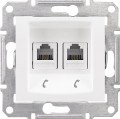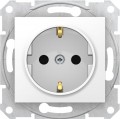Features
— Electric. The connection is represented by a plug connection. This is an ordinary plug that is attached to the current-carrying wire of the consumer of electricity. There are many types of power outlets. Both single and double (triple) models are widely used. Manufacturers of electrical equipment offer traditional and "smart" (smart) sockets. Some models of classic (traditional) sockets are equipped with a built-in programmer.
—
Computer (RJ45). The computer socket uses an Ethernet connector, under the RJ45 connector. With its help, you can connect computer or other digital equipment to a local network (home or corporate) and access the Internet. Usually, sockets of this type are mounted next to the desktop or in the place of stationary placement of digital / peripheral equipment. Often a computer outlet is used to connect cable television or IPTV. The vast majority of models use a built-in design (flush-mounted), although some electrical manufacturers still produce surface-mounted outdoor RJ45 sockets.
—
Telephone. Telephone sockets use an RJ11 or RJ12 connector. With the help of sockets of this type, stationary city telephones are connected, as well as devices of an internal telephone line (corporate). Additionally, telephone sockets can be used for ADSL Internet connection. Usually, models of this type are mounted near the installation site of fixed telephones, as well as routers
...(routers) with an ADSL connection.
— Computer + phone. Combined sockets. The contact group, as well as the front decorative surface, is designed to install several different types of connectors (RJ45 + RJ11), more details about each of them can be found in the relevant paragraphs. Sockets of this type are often installed near the desktop.
— Computer + TV. The socket is equipped with heterogeneous interfaces: RJ-45 and coaxial TV connector. Designed for installation next to a multimedia entertainment system, which necessarily includes a TV and auxiliary digital/computer equipment (game console, media player, etc.). The TV connector is used to transmit a television signal, and the RJ-45 interface is designed to access the Internet or connect to a local network. In some cases, an RJ-45 computer connector can be used to transmit an IPTV television signal.
— Electricity + USB. Sockets of this type are designed for both traditional plug-in connection and connection using a USB port. The plug + USB combination allows the product to serve a wide range of devices, including gadgets and digital devices, which often do not have a fixed current-carrying wire with a plug.
— USB. USB sockets are designed to charge smartphones, tablets and other computer/digital devices. Depending on the specific model, the product may have 2-4 USB connectors for connecting several devices at the same time. There are models on the market for both flush-mounted and surface-mounted installations. Often, a USB connector is combined with a traditional plug connection (combined sockets).
— HDMI. The HDMI (High-Definition Multimedia Interface) interface is designed to transmit high-definition multimedia data. An HDMI socket allows you to neatly and practically connect the elements of a home theater or entertainment centre — it can be a large-screen TV and a computer. Usually, they are mounted in places where the screen and media library server are permanently placed. The vast majority of models are built-in and installed in mounting boxes.
— Audio. Audio sockets allow you to aesthetically, reliably and safely connect the main elements of the sound path of a home theater, stereo or multimedia system. Using audio sockets, you can connect speakers to an amplifier or directly to a sound source (player, music centre, DVD player, etc.).
— Audio-video (AV). Sockets with composite RCA connectors for audio and video signal connection. At this time, in the era of digital devices, it is considered an outdated way to connect AV equipment.
— Television TV. TV is a terrestrial television broadcast transmission standard. Television sockets TV use an analogue signal received from a radio antenna, which can operate in both the metre and decimetre frequency ranges. When choosing a socket of this type, the type of electrical accessories should be taken into account. There are through and end sockets. In addition, it is necessary to take into account the connection scheme (stub or "asterisk").
— Television SAT. SAT is an interface for transmitting a satellite television signal. SAT television outlets use a digital signal from a satellite dish. The SAT broadcasting standard operates in the 950-2400 MHz frequency range. Usually, the SAT signal is broadcast without interference; if the satellite signal strength is insufficient, the channel is blocked. There are pass-through and terminal SAT-sockets. The SAT interface is often combined with other television and radio broadcasting connectors, TV and R.
— Television TV-SAT. Combined sockets that allow you to use the signal from both traditional antennas for terrestrial broadcasting (TV) and satellite dishes (SAT). Television sockets TV-SAT are most often installed on those objects that are equipped with various types of antennas (metre / decimetre + satellite). They can be both passing and terminal. The tandem of TV-SAT interfaces can be supplemented with a connector for connecting FM/AM radio.
— Television TV-R. TV sockets TV-R work both with a signal from a classic metre / decimetre antenna, and with a signal from an AM / FM radio antenna. It is advisable to use the TV-R socket when the TV, player or receiver is equipped with a radio tuner. There are several types: through and terminal. TV outlets can be additionally equipped with a SAT satellite connector.
— Television TV-R-SAT. The combination of TV-R-SAT interfaces involves the use of signals from a metre / decimetre antenna, an AM / FM radio antenna and a satellite dish. Combined TV-R-SAT sockets are designed for installation in those facilities where a complete set of television and radio broadcasting antennas is used. When choosing a TV-R-SAT socket, you should pay attention to the design of the electrical fittings. There are through and end models.Grounding
Sockets with grounding are intended for maintenance of industrial machinery and other equipment. The plug of equipment that requires grounding has an additional contact surface (grounding). Thanks to grounding, the socket protects the serviced equipment from short circuits and other power outages. To install models of this type, it is necessary that the electrical switchboard is equipped with a working ground terminal, and the power cable has an auxiliary conductor connected to ground in the switchboard.
Rated current
The current strength of the outlet determines how powerful the equipment it can power. A standard
16 A household outlet allows you to safely service equipment up to 3.52 kW. The maximum power of consumers is calculated by the formula: network voltage (220 V) * socket current.
In the past, standard household outlets used an amperage rating of 6.3 A. But over time, more electrical appliances have been used in homes, forcing manufacturers to raise the standard amperage rating. If you connect a splitter (carrying device) to a 16 A socket that serves equipment with a total power of over 3.52 kW, the socket may melt.
Sockets with a rated current of 25 and 32 A are intended for installation in production and industrial facilities. Typically they use a 3-phase 380 V network.
Maximum power
The value of the maximum power of the outlet determines the total power of consumers that are powered from it.
This parameter is inextricably linked with the rated current of the outlet. So, an ordinary household socket with a rated current of 16 A is capable of servicing equipment with a power of up to 3.52 kW. The maximum power is determined by the formula: voltage (230 V) * rated current. So, for example, W = 220 * 16 = 3520 W. If more powerful equipment is connected to an outlet with a maximum power of 3.52 kW, the outlet will melt.
Protective shutters
Protective shutters block free access to the electrocontact group. To use an outlet with curtains, the user must first remove the curtains themselves. Models of this type are mainly intended for installation in facilities where there are small children. Protective curtains prevent cases when a child sticks thin metal objects (hairpins, needles, knitting needles, etc.) into the plug holes.
Wire connection
— Screw.
A screw connection involves fixing each wire with a special plate, which is pressed against the bare part of the wire under the action of screwing in a bolt (screw). This type of connection, although considered obsolete today, is still often used even by manufacturers of advanced electrical accessories. The screw-type clamp allows you to control the clamping force of the wiring, but due to temperature instability, the threaded connections of the electrocontact group are subject to self-unwinding. This moment leads to a weakening of the clamping of the wiring and deterioration of the contact.
— Clamp. The self-clamping terminal fixes the bare part of the wire due to the force of the stretched spring. To connect the wire, you must first press the tab of the terminal clamp by hand, and releasing the tab, the clamp will securely fix the contact part of the wire. Wiring with clamps is considered a more modern and reliable solution than the classic screw fixing method, since the terminal clamps are not subject to self-loosening. Among the shortcomings, one can single out the impossibility of controlling the clamping force.
Max. connected wire section
For an ordinary household plug socket, wires with a cross section of 2.5 mm² are used. This type of wiring can withstand a power load of up to 3.5 kW for each of the outlets. Regarding sockets that serve large household appliances, their electrical contact group is designed for wires with a larger cross section.
Embedding depth
The insertion depth of the socket must correspond to the depth of the mounting box. Usually, the standard installation depth is 40 mm. But there are models with both smaller and larger installation depths. For example, narrow sockets require only 25 mm depth from the back box. Additionally, there is a series of sockets that require at least 60 or even 80 mm depth from the mounting box.
Frame thickness
This parameter is applicable to built-in electrical fittings. The thickness of the frame determines how much the outlet will protrude from the wall. In the average model, this figure is in the range of 7-10 mm. The thinner the frame, the more neat the socket will look.

